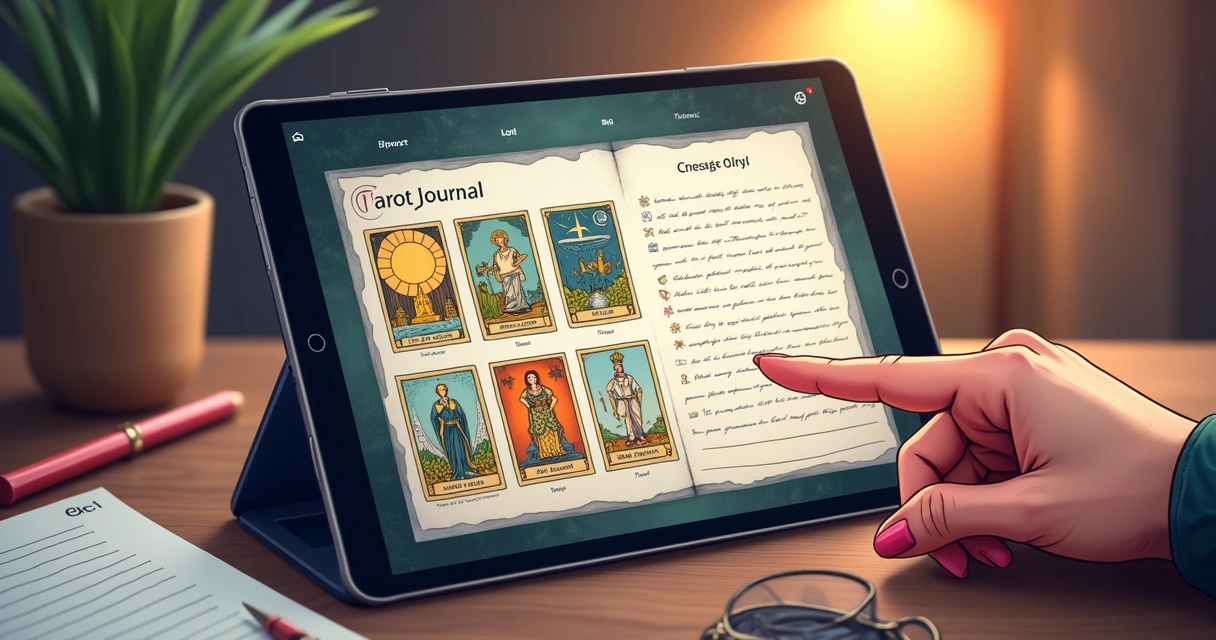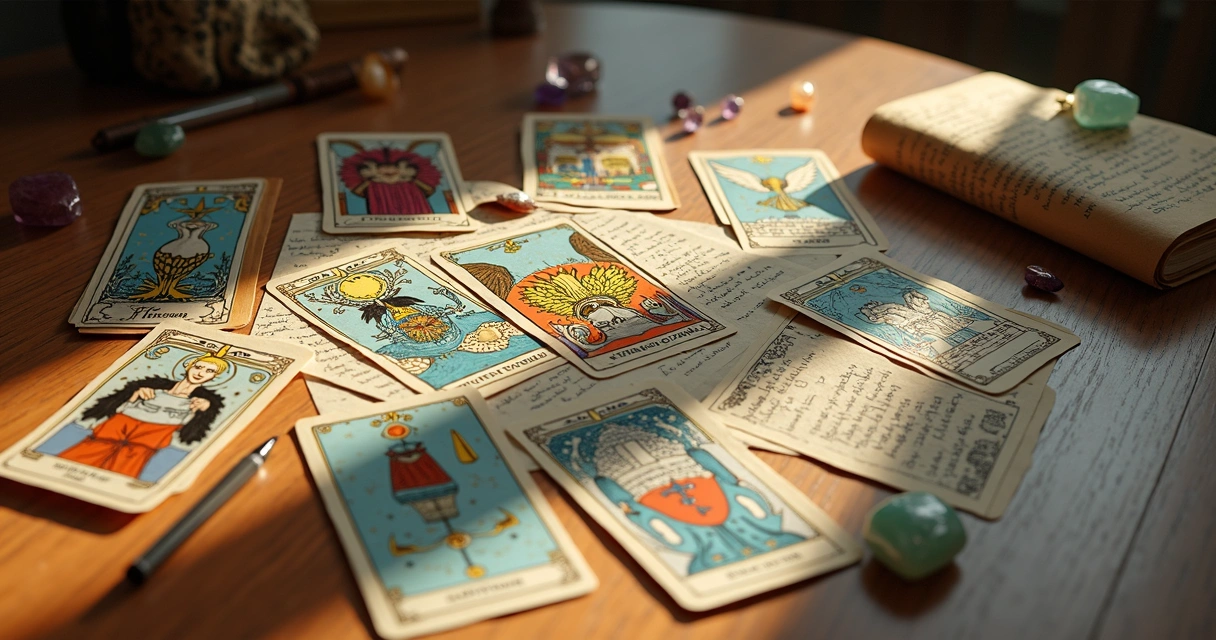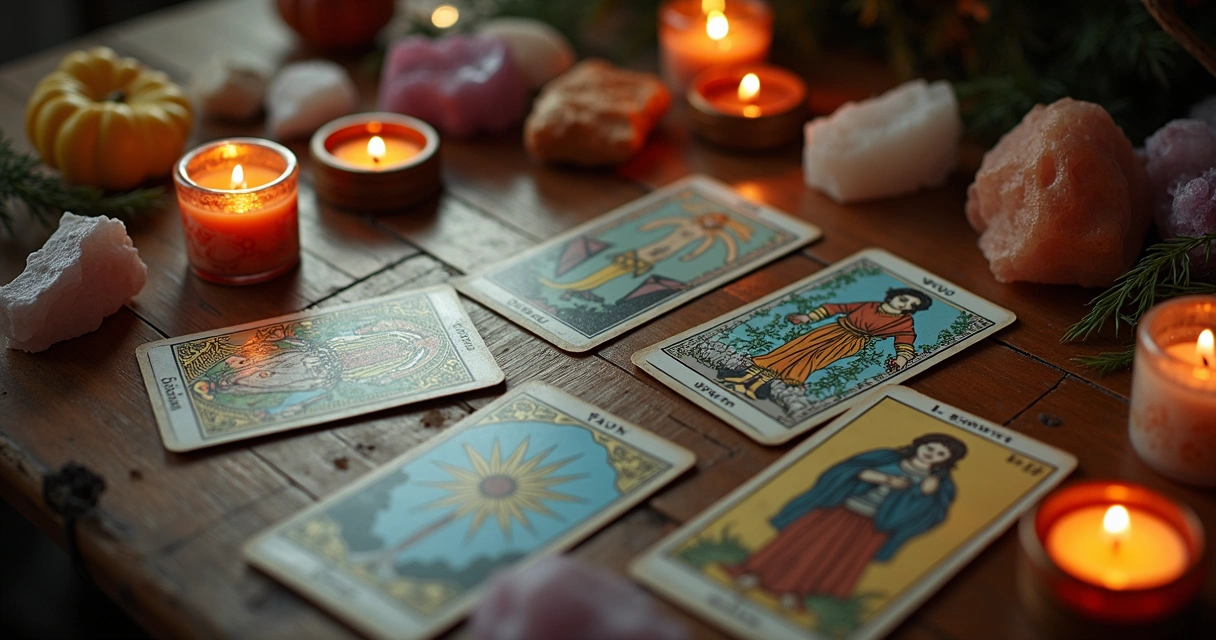Starting to learn tarot online can feel both exciting and a little overwhelming. There are hundreds of resources, platforms, and methods at our fingertips, each with its own promise of insight. But what’s the best way for us to make sense of it all? Over the years, we’ve seen that mixing tried-and-true learning strategies with new digital possibilities offers a strong foundation for anyone who wants to read tarot with confidence. In this practical guide, we’re sharing our experience with studying tarot virtually—from choosing lessons, to recording progress, to working with digital tools like MysticLog that turn scattered notes into wisdom you can revisit and build upon.
 Why study tarot with online resources?
Why study tarot with online resources?
We’re living in a unique time for tarot study. After all, learning these cards once meant either tracking down a rare teacher or relying on dense print books. Now, with online learning, we can join global communities, watch real readers share their insights, and use interactive platforms to organize every reading we do. There’s a kind of privacy, convenience, and diversity of voices that simply didn’t exist before—the accessibility and convenience of online tarot is remarkable for modern learners as discussed by university research.
If you’re new, here’s the thing: Online tarot learning flattens the distance between beginner and expert. You don’t need to sit at the feet of a master to begin seeing patterns and meaning in the cards. Tools like digital workbooks, AI chat assistants, and online study groups create the support and structure you need—while letting you move at your own tempo.
Choosing your first tarot course or self-guided path
Structured courses can be a strong launchpad and often provide a clear roadmap. When we’re asked about where to begin, we usually suggest starting with an overview of the tarot structure itself: understanding the Major and Minor Arcana, the suits, and the journey those cards represent. Many online courses are tailored for beginners and include lessons on card meanings, classic spreads like the Three-Card or Celtic Cross, and practical reading exercises. If you need a clear step-by-step, these lesson plans often suit those who like a classroom feel, even from home.
- Structured courses: These are paid or free series of lessons, often including videos, downloadable notes, and community forums.
- Video walkthroughs: Excellent for visual learners who want to watch real readings or see card symbolism explained in context.
- Open educational resources: E-books, printable PDFs, and introductory guides—like this University of Massachusetts primer on tarot—offer time-tested approaches and background on tarot’s rich history.
- Self-paced learning: Many of us prefer to pick up a deck and learn by experiencing the cards ourselves. Online journaling and study blogs are great companions for this slower but rewarding way.
We always encourage you to mix and match approaches—sometimes a short course helps build confidence, but daily practice and reflection bring the deck to life.
Learning key concepts: card meanings, tarot spreads, and symbolism
Every reader faces a big question early on: “How do I understand what each card means, and how they speak together in a spread?” The learning curve can seem steep, but it softens with consistent exposure and hands-on application.
The basics: major arcana, minor arcana, and suits
The historical evolution of tarot shows us that the deck has roots going back centuries, first as playing cards, then as a system for storytelling and self-discovery. Each card is rich with symbols, colors, and archetypes—recurring themes that represent forces or stages within human experience.
- The Major Arcana: 22 cards representing major life themes, such as The Fool (new beginnings), The Lovers (relationships and choices), or The World (completion).
- The Minor Arcana: 56 cards divided into four suits: Cups (emotions), Wands (action), Swords (thought), and Pentacles (material), each running ace to king.
Every card carries its own story. It’s natural to start remembering the cards by their images, keywords, and the feelings they evoke. Don’t feel pressured to memorize all 78 at once; many readers begin with the Major Arcana before adding the rest.
Understanding tarot spreads
“Spread” is just the word for how you lay out the cards to answer a question. The classic three-card spread looks at past, present, and future, or sometimes situation, challenge, and advice. Larger spreads like the Celtic Cross can help with more complex questions, though we often recommend sticking with 1-3 card readings when starting out. The key is not just what cards appear, but how they connect and tell a story together.
Building stories with your cards brings insight and trust in your own intuition.
For a practical step-by-step on choosing spreads and interpreting them, our guide to using tarot for self-discovery offers approaches you can try right away.
Making the most of digital tarot journals and interactive tools
Perhaps the single most useful habit for online tarot learners is keeping a digital tarot journal. With platforms like MysticLog, you can log draws, attach personal notes, and revisit your progress all in one place. Here’s why this is helpful:
- Tracking patterns: Over time, you’ll notice recurring cards and themes, which deepen your self-reflection and show areas of growth.
- Storing interpretations: No more lost scraps of paper—everything is searchable, and you can pick up where you left off.
- Confidence-building: Having a record makes it easier to see how your interpretations evolve, which is motivating in those uncertain early months.
- Prompted learning: Some digital tools offer AI assistants that can suggest card meanings, ask clarifying questions, or help structure your interpretations—much like a study buddy who’s available at any hour.
If you want more on reflective journaling, our step-by-step journaling guide for tarot offers prompts and template ideas that fit wonderfully within digital learning.
 Practical exercises and developing intuition
Practical exercises and developing intuition
In our experience, the secret to growing as a tarot reader lies in regular practice. It’s through touching the cards, reflecting on outcomes, and returning to your notes that real learning happens. Online studies suggest daily draws or reflection with tarot cards offer strong support for personal growth and self-understanding (daily tarot analysis guide and as confirmed by divination research from Fordham University).
Here’s a simple path we recommend:
- Draw a card daily. Ask a gentle question (“What do I need to be aware of today?”) and reflect on the card’s image and message.
- Capture your first thoughts. Use a notebook or app like MysticLog to record your reactions. Don’t filter; let your impressions be raw.
- Return later. At the end of the day or week, see how the card’s meaning played out in your experiences. What felt accurate? What shifted?
- Repeat for a few weeks. Patterns and deeper insights may start to appear, especially if you reflect on your old entries, not just the new ones.
Over time, you’ll get a feel for tarot’s archetypes—those bigger-than-life characters and themes that show up across history, myth, and psychology. Intuition grows not by forcing answers, but through honest noticing and openness. It might sound a little poetic, but it works. Many readers are surprised how much their gut sense sharpens over time, just through steady attention and review.
Looking for more practical strategies to build confidence? Our confidence-building guide for tarot readers speaks directly to this part of the journey.
How online communities and digital learning foster growth
One of the best parts of studying tarot in a digital environment is the ability to connect with others—regardless of distance or schedule. Discussion boards, social channels, and dedicated study groups can be welcoming places to share your readings or ask questions; the diversity of opinions often sparks unexpected breakthroughs. If you’re feeling isolated or stuck, a quick chat with other learners (or with an AI assistant like MysticLog’s) can be reassuring.
These groups also make it normal to talk openly about the messy, in-progress nature of skill-building. It’s not all about polished readings. Sharing both ‘aha!’ moments and honest uncertainties lets everyone realize: growth comes from curiosity, patience, and support, not from being flawless.
For more background on the benefits of online tools for tarot learning, see the overview of online tarot readings from Vanderbilt University research.
Tips for staying organized and making online study work for you
- Set realistic goals. Maybe that’s three cards a week, or one new spread a month. Small steps keep things moving without stress.
- Keep your resources in one place. Bookmark favorite blogs, guides, and your digital journal—this makes review and ongoing study much easier. The tarot study blog from MysticLog is an easy starting point.
- Use reminders and AI assistance strategically. Features like notifications for daily draws, or friendly nudges from tools like MysticLog’s AI assistant, can keep you engaged.
- Reflect regularly, not just read. Look back on past readings to notice growth, not just accuracy. Your interpretations will develop along with you.
 Conclusion: tarot learning is personal—and digital tools can help
Conclusion: tarot learning is personal—and digital tools can help
We’ve seen all kinds of beginnings turn into something real. Some people study tarot online for self-reflection, some to help others, some just to see what hidden stories might unravel in their lives. There’s no “one best way,” only your way—the one that lets you come back again and again, learning from the cards, the community, and yourself. With the right mix of courses, journaling, and interactive support, your tarot journey can be clear, organized, and deeply rewarding.
Your story with tarot can start right now, wherever you are.
If you want to stay organized, supported, and confident in your practice, we invite you to discover more with MysticLog—your digital ally in tarot, runes, and Lenormand study. Give your learning a foundation that’s practical, accessible, and uniquely your own.
Frequently asked questions
What is the best way to learn tarot online?
The most effective way to learn tarot virtually is to blend structured lessons with daily hands-on practice and regular journaling. For many, a mix of online beginner courses, consistent single-card draws, and reflective notes brings rapid growth. Using digital tools like MysticLog can support progress tracking and reinforce intuitive skills.
Are free tarot courses online reliable?
Free online tarot courses and guides can be very useful if they come from sources that explain fundamentals clearly, use well-known card meanings, and encourage regular personal reflection. While paid courses sometimes provide more structure, we’ve found that many free resources—with attention and review—can be a strong starting point.
How long does it take to learn tarot online?
Most learners can confidently interpret basic cards and perform simple readings within a few weeks or months of steady effort. As research from Vanderbilt University notes, daily practice is key. Mastery develops over time, but you’ll notice real growth just by engaging regularly.
Where can I find tarot study groups online?
Online tarot study groups can be found in forum communities, social media groups, and digital platforms committed to tarot learning. Check within established digital journals or apps with discussion features, or seek focused communities that welcome beginners, such as those highlighted on the MysticLog tarot blog.
Is it worth it to study tarot virtually?
Yes—studying tarot in a digital environment offers flexibility, the chance for private reflection, access to diverse resources, and broadens your network for self-growth. As examined in this overview of online tarot study, virtual learning is a reliable choice whether you’re just starting or deepening an established practice.




